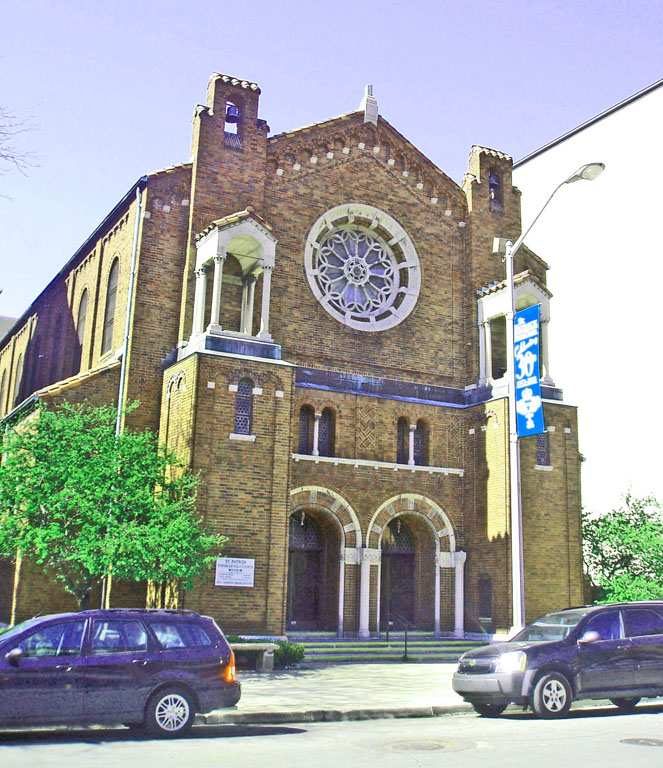

In 1860, the Catholic diocese of Detroit began building a massive church nearby at the corner of John R. and Adalaide. The architects, Albert and Octavius Jordan and James Anderson, designed an impressive Gothic Church with two large spires and an impressive entryway. The church was opened on St. Patrick's day in 1862. The area along Adalaide had numerous farms when construction began but, shortly thereafter, the industrial development of Detroit meant the area was converted into residences. Just nine years after completion of St. Patrick's, it was doubled in size to seat 1,200 congregants, making it one of the largest churches in the state in the 1870s. The cathedral church for the Catholic diocese had been Sts. Peter and Paul at 629 East Jefferson, but in 1877, this church was transfered to the Jesuit order with the understanding that they would staff the church and establish a Catholic college in the city, the school that is now known as University of Detroit Mercy. For some years, St. Aloysius Church was used as the cathedral, but in October, 1890, Bishop Foley designated St. Patricks as the cathedral and renamed it Sts. Peter and Paul, borrowing the name from the former cathedral.
Edward Mooney was appointed Bishop of Detroit in 1937 and the dioceses was upgraded by the Roman administrators to Archdiocese. Wishing to symbolize the change, Bishop Mooney decided that the Church of the Most Blessed Sacrament on Woodward should be the cathedral so Sts. Peter and Paul lost that status. The population living near John R. and Adaliade declined rapidly after World War II as Brush Park declined in population size and prosperity. The number of worshipers sunk, and in 1973, the church was closed. However, the original parish name, St. Patricks, was transfered to the Chapel of St. Theresa nearby at 46 Parsons. The original St. Patrick's church at John R. and Adalaide burned to the ground in May, 1993 after being vacant for two decades
The parish school for Sts. Peter and Paul did not adjoin the church. Instead Sts. Peter and Paul Academy was built at 60 Parsons and staffed by the Immaculate Heart of Mary Sisters. The nuns, presumably, wished to have the students attend Mass and other religious services but to do so, they had to walk several blocks and cross busy Woodward Avenue to get from their school to the parish church. There was a need for a much closer church.
St. Theresa of Lisieux, born in 1873, was the ninth and final child born to a middle-class family in Normandy. Her father earned his living as a watchmaker. At age 15, she joined the Carmelite Order and became a nun. She was a prolific writer who drafted many moving spiritual poems. Perhaps she was best known for her autobiography, Story of a Soul. She was born seventy years before the sulfa drugs became available, so it may be no surprise that she died of tuberculosis in Lisieux at age 26. Just 24 years after her death, Pope Pius XI proclaimed her a saint in 1925 and then, at the centennial of her death, Pope John Paul II declared that she was a Doctor of the Church. Theresa portrayed herself as a “little flower of Jesus,” hence her sobriquet.
Capitalizing upon the popularity of St. Theresa at the time of her cannonization, Bishop Gallagher established a nine-day novena for public worship at Sts. Peter and Paul church. This drew large crowds so the novena was repeated in 1926. Once again, large crowds participated in the nine-day novena honoring St. Theresa. Bishop Gallagher presumed that there was so much interest in her that a special chapel should be built to honor her. This is the church you see pictured above. It obviously also served the needs of the several hundred children who attended the school next door. In 1926, the lovely Chapel of St. Theresa that you see was built to serve the needs of the school children, reflecting, of course, the economic prosperity of the city’s well-assimilated Catholic population. Please note the graceful arches at the entrance, the appealing rose window, the open Romanesque towers facing Parsons and the picturesque arrangement of the twin bell towers. This is a beautiful religious structure, well worth a detour if you are driving toward or away from downtown Detroit.
Please don't get two confused about the names Catholics gave their churches. The original Sts. Peter and Paul Church is still in operation at East Jefferson. I believe this is the oldest religious building in continuous use in Detroit although the present Second Baptist Church may be built upon a foundation dug earlier than the one for Sts. Peter and Paul.
Architects: John Donaldson and Henry J. Meier
Date of construction: 1926
Architectural Style: Neo-Romanesque with Spanish and Italian influences.
Use in 2009: Roman Catholic Church
Website for church: http://stpatrickchurchdet.com/06/
City of Detroit Local Historic District: Not listed
State of Michigan Registry of Historic Places: Not listed
National Register of Historic Sites: #97001099, Listed September 22, 1997
Use in 2005: Roman Catholic Church
Photograph: Ren Farley; May, 2005
Description updated: March 16, 2009
Return to Cass Farm Multiple Property Submission